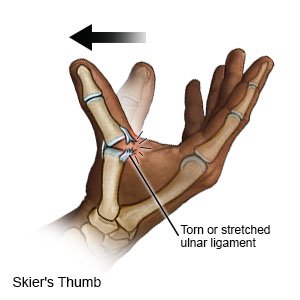Skier's Thumb
Medically reviewed by Drugs.com. Last updated on Aug 4, 2025.
AMBULATORY CARE:
Skier's thumb
, or gamekeeper's thumb, is when a ligament in your thumb is stretched or torn. Ligaments are strong tissues that connect bones and keep them in place, and support your joints.
 |
Common signs and symptoms include the following:
- Pain, tenderness, and swelling
- Bruising
- Trouble holding or pinching things between your thumb and fingers
- Misshapen thumb
- Trouble moving your thumb
- A lump in your thumb
Seek care immediately if:
- You have severe thumb pain.
- Your thumb or fingers look pale and feel cold.
Contact your healthcare provider if:
- You have numbness or tingling in your thumb or fingers.
- Your symptoms get worse, even with treatment.
- You have questions or concerns about your condition or care.
Treatment:
- NSAIDs , such as ibuprofen, help decrease swelling, pain, and fever. This medicine is available with or without a doctor's order. NSAIDs can cause stomach bleeding or kidney problems in certain people. If you take blood thinner medicine, always ask your healthcare provider if NSAIDs are safe for you. Always read the medicine label and follow directions.
- Acetaminophen decreases pain and fever. It is available without a doctor's order. Ask how much to take and how often to take it. Follow directions. Read the labels of all other medicines you are using to see if they also contain acetaminophen, or ask your doctor or pharmacist. Acetaminophen can cause liver damage if not taken correctly.
- Prescription pain medicine may be given. Ask your healthcare provider how to take this medicine safely. Some prescription pain medicines contain acetaminophen. Do not take other medicines that contain acetaminophen without talking to your healthcare provider. Too much acetaminophen may cause liver damage. Prescription pain medicine may cause constipation. Ask your healthcare provider how to prevent or treat constipation.
- Support devices include a removable splint, elastic bandage, or thumb cast. These are used to decrease or prevent movement of your thumb so it can heal. They are also used to prevent further damage to your thumb. These devices may be worn for 3 to 6 weeks.
- Surgery may be done if you have a severe injury, such as a completely torn ligament. Broken bones will also be fixed during surgery, if needed. Wires and screws may be used to hold your bones together while your ligament heals. You will need to wear a support device after your surgery.
- Physical therapy may be recommended after your injury has healed. A physical therapist teaches you exercises to help improve movement and strength, and to decrease pain.
Manage your symptoms:
- Rest your thumb as directed. You will need to limit certain activities while your injury heals. Ask your healthcare provider what activities are safe to do.
- Apply ice on your thumb for 15 to 20 minutes every hour or as directed. Use an ice pack, or put crushed ice in a plastic bag. Cover it with a towel. Ice helps prevent tissue damage and decreases swelling and pain.
- Elevate your hand above the level of your heart as often as you can. This will help decrease swelling and pain. Prop your arm on pillows or blankets to keep your hand elevated comfortably.
Follow up with your doctor as directed:
Write down your questions so you remember to ask them during your visits.
© Copyright Merative 2025 Information is for End User's use only and may not be sold, redistributed or otherwise used for commercial purposes.
The above information is an educational aid only. It is not intended as medical advice for individual conditions or treatments. Talk to your doctor, nurse or pharmacist before following any medical regimen to see if it is safe and effective for you.
Learn more about Skier's Thumb
Care guides
Further information
Always consult your healthcare provider to ensure the information displayed on this page applies to your personal circumstances.
